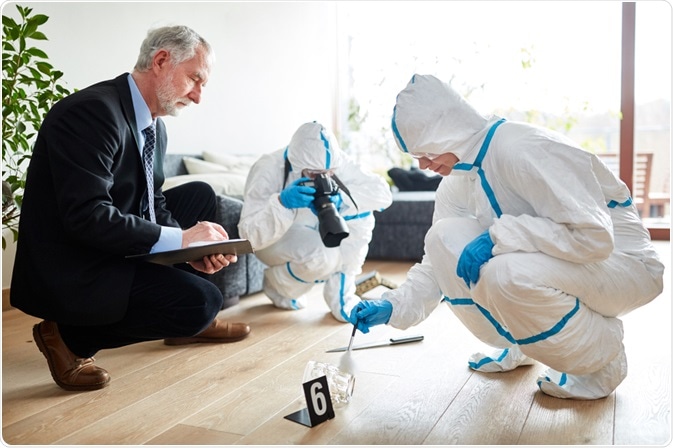As courts view eyewitnesses as unreliable or biased over time, physical evidence from the crime scene has played a vital role in providing investigating leads, linking a suspect and/or victim to a crime committed, exonerating the innocent, or disproving an alibi. Nevertheless, it is important to note that not all evidence serves a probative value, that is, the meaningful information from the analysis of evidence as it relates to determining a fact that is in question. Therefore, the priority of potential evidence found at a crime scene must be examined based on each of their relevance to the case.
Since the role of physical evidence plays a huge impact in law enforcement, the recognition, collection, preservation, and analysis of the evidence must be properly maintained. Without the proper handling and processing of evidence, the forensic value of the evidence can diminish or be inadmissible in court.

Evidence at Crime Scene. Image Credit: Robert Kneschke/Shutterstock.com
Chain of custody for handling evidence
Chain of custody is a crucial process in the case of evidence documentation to prove to the court that the evidence seized at the crime scene is in the same condition as it is when presented in court. The process further ensures that the evidence has not been tampered with or altered in its processing from the crime scene to the forensic laboratory until it is admitted in court.
Chain of custody preserves the integrity of the evidence by maintaining a paper trail who has had contact with the evidence that should testimonies be required, the individuals involved can be summoned to court. The chain of custody needs to cover every transfer from when the evidence is collected at the crime scene, and from one individual to another to restrict unauthorized individuals from accessing the evidence.
Collecting different types of physical evidence
The classification of physical evidence plays an important role in assessing how crime scene investigators should approach the collection and recognition of the evidence. Furthermore, crime scene investigators should also be familiar with the value as well as the limitations for the different types of evidence present at a crime scene. Then based on the examination of this physical evidence that the investigator can eventually reconstruct the crime scene.
Physical evidence is usually classified based on the nature of the evidence: transient, transfer, or associative evidence. Transient evidence is evidence that when not preserved properly, can easily be lost or altered and therefore must be documented as soon as possible. Examples of transient evidence could be the odor or color change of an item.
Transfer evidence, or also known as trace evidence, is a type of evidence that is a result of physical contact between objects and/or persons. Whereas associative evidence refers to items that serve as evidence to associate a suspect or a victim to a specific crime scene. Although physical evidence can provide a link of a suspect and/or victim to a particular crime scene, not all physical evidence can identify a suspect but rather an indirect lead or supporting evidence to solve a crime.
Collecting and preserving biological evidence at the crime scene
Biological specimens such as DNA are highly sensitive evidence and therefore proper handling, as well as preservation, must be maintained. For instance, as a sufficient amount of DNA is needed for analysis purposes, a significant amount of biological evidence must be swabbed. However, the crime scene investigator must do so without collecting other interfering materials that could compromise the quality of DNA.
The biological material must also be placed in a cool, dry environment away from heat as well as sunlight to minimize the deterioration and potential chemical crosslinks of the material respectively. Humidity may also promote the growth of microorganisms that could compromise the quality of DNA.
The most proper way to collect DNA before submitting the sample to the laboratory is to store the evidence in paper bags or envelopes that are sealed and labeled. Plastic bags should be avoided as moisture will affect the preservation of DNA.
In the case of biological evidence transparent to the naked eye, various light sources such as visible, UV, or laser light can be used to capture the appearance of the stain. Blood, saliva, and semen emit fluorescent light with specific wavelengths that require filters to observe these stains.
The biological samples containing DNA are stored in refrigerators to prevent degradation and to preserve their quality prior to analysis. Furthermore, as contamination could cause problems in data interpretation, proper precautions must be taken by crime scene investigators as well as DNA analysts when handling samples.
For instance, gloves must be used by all individuals handling evidence, with frequent changes to prevent contamination, and instruments must be cleaned or disposed of prior to contact with evidence. The biological evidence must be air-dried before placing them in the appropriate packaging and touching the face during evidence collection must be avoided.
Sources:
- Lee, H. C., Ladd, C., 2001. Preservation and Collection of Biological Evidence. In Croatian Medical Journal, 42(3), pp. 225-228. https://citeseerx.ist.psu.edu/
- Badiye, A., Kapoor, N., Kathane, P. and Shukla, R.K., 2020. Quality Control in Forensic DNA Typing. In Forensic DNA Typing: Principles, Applications, and Advancements (pp. 585-605). Springer, Singapore.
- National Criminal Justice Reference Service. n.d. What Every Law Enforcement Officer Should Know About DNA Evidence. [online] Available at: <https://www.ncjrs.gov/nij/DNAbro/evi.html> [Accessed 21 May 2021].
Further Reading